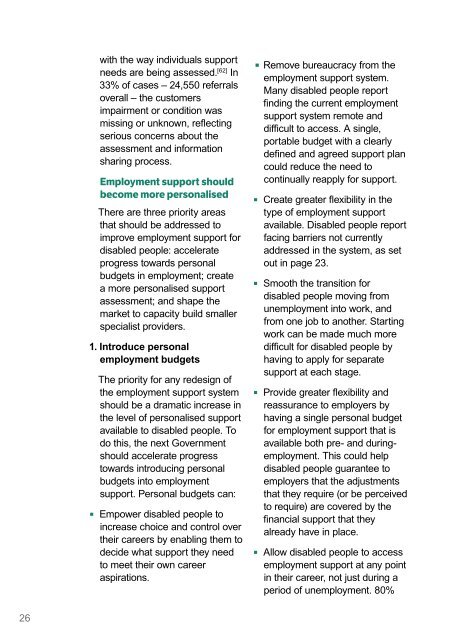A-million-futures-halving-the-disability-employment-gap.pdf?ext=
A-million-futures-halving-the-disability-employment-gap.pdf?ext=
A-million-futures-halving-the-disability-employment-gap.pdf?ext=
Create successful ePaper yourself
Turn your PDF publications into a flip-book with our unique Google optimized e-Paper software.
with <strong>the</strong> way individuals supportneeds are being assessed. [62] In33% of cases – 24,550 referralsoverall – <strong>the</strong> customersimpairment or condition wasmissing or unknown, reflectingserious concerns about <strong>the</strong>assessment and informationsharing process.Employment support shouldbecome more personalisedThere are three priority areasthat should be addressed toimprove <strong>employment</strong> support fordisabled people: accelerateprogress towards personalbudgets in <strong>employment</strong>; createa more personalised supportassessment; and shape <strong>the</strong>market to capacity build smallerspecialist providers.1. Introduce personal<strong>employment</strong> budgetsThe priority for any redesign of<strong>the</strong> <strong>employment</strong> support systemshould be a dramatic increase in<strong>the</strong> level of personalised supportavailable to disabled people. Todo this, <strong>the</strong> next Governmentshould accelerate progresstowards introducing personalbudgets into <strong>employment</strong>support. Personal budgets can:•Empowerdisabled people toincrease choice and control over<strong>the</strong>ir careers by enabling <strong>the</strong>m todecide what support <strong>the</strong>y needto meet <strong>the</strong>ir own careeraspirations.Remove bureaucracy from <strong>the</strong><strong>employment</strong> support system.Many disabled people reportfinding <strong>the</strong> current <strong>employment</strong>support system remote anddifficult to access. A single,portable budget with a clearlydefined and agreed support plancould reduce <strong>the</strong> need tocontinually reapply for support.•Creategreater flexibility in <strong>the</strong>type of <strong>employment</strong> supportavailable. Disabled people reportfacing barriers not currentlyaddressed in <strong>the</strong> system, as setout in page 23.•Smooth<strong>the</strong> transition fordisabled people moving fromun<strong>employment</strong> into work, andfrom one job to ano<strong>the</strong>r. Startingwork can be made much moredifficult for disabled people byhaving to apply for separatesupport at each stage.•Providegreater flexibility andreassurance to employers byhaving a single personal budgetfor <strong>employment</strong> support that isavailable both pre- and during<strong>employment</strong>.This could helpdisabled people guarantee toemployers that <strong>the</strong> adjustmentsthat <strong>the</strong>y require (or be perceivedto require) are covered by <strong>the</strong>financial support that <strong>the</strong>yalready have in place.•Allowdisabled people to access<strong>employment</strong> support at any pointin <strong>the</strong>ir career, not just during aperiod of un<strong>employment</strong>. 80%of disabled people are in workwhen <strong>the</strong>y acquire a condition orimpairment. [63] Providing supportfor <strong>the</strong>m and <strong>the</strong>ir employers tomake necessary adjustmentsduring this period of changeis vital.There is already evidenceshowing how personal budgetscould work in practice, includinginternational examples [64] , and<strong>the</strong> considerable lessons learntfrom <strong>the</strong> introduction of personalbudgets in social care.These include:An individual should havea person-centred supportassessment, carried out by atrained specialist advisor. Thisassessment should be availableat different points in a disabledperson’s career, not just when<strong>the</strong>y are unemployed.Following <strong>the</strong> assessment, <strong>the</strong>financial level of support aperson can receive will bedetermined, and a range ofactivities decided in partnershipbetween <strong>the</strong> advisor and <strong>the</strong>disabled person that <strong>the</strong>y canuse to ei<strong>the</strong>r i) find and preparefor work, or ii) adjust <strong>the</strong>workplace to keep <strong>the</strong>ir job.Where an individual is a jobseeker, a ‘Return to WorkPlan’ will form <strong>the</strong> basis ofaccountability for <strong>the</strong> disabledperson to carry out certainactivities to replace currentblanket conditions and sanctionsfor non-compliance, and toensure <strong>the</strong> budget is spentas agreed.Different payment options shouldbe available to <strong>the</strong> disabledperson, including a DirectPayment and a managed budget.However, <strong>the</strong>re are still keychallenges in introducingPersonal Employment Budgets,notably around <strong>the</strong> local marketof support available to disabledpeople. As such, <strong>the</strong>re is a clearrole for a new market-shapingbody, separate from DWP, tooversee <strong>the</strong> introduction ofpersonalisation into<strong>employment</strong> support.2. Create a more personalisedassessmentThe Work Capability Assessmentis no longer fit for purpose.Evidence from Disabled People’sOrganisations [65] , officialreviews [66] and consultations,frequent media reports [67] andMPs’ own correspondence [68] allhighlight <strong>the</strong> significant personalharm that is being caused bydisabled people being found fitfor work inappropriately. Over80% of respondents to a recentDisability Benefits Consortium(DBC) survey ei<strong>the</strong>r stronglyagreed or agreed that <strong>the</strong> stressof <strong>the</strong> WCA had made <strong>the</strong>ircondition or impairment worse.At <strong>the</strong> heart of <strong>the</strong> failure of <strong>the</strong>assessment is a debate about26 27


